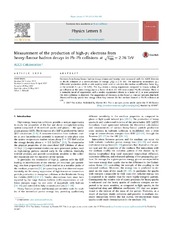Measurement of the production of high-\(p_{\rm T}\) electrons from heavy-flavour hadron decays in Pb–Pb collisions at \(\sqrt{s_{\rm NN}}=2.76\) TeV
Adam, Jaroslav; Adamová, Dagmar; Aggarwal, Madan M.; Aglieri Rinella, Gianluca; Agnello, Michelangelo; Agrawal, Nikita; Ahammed, Zubayer; Ahmad, Shafiq F.; Ahn, Sang Un; Aiola, Salvatore; Alme, Johan; Helstrup, Håvard; Hetland, Kristin Fanebust; Kileng, Bjarte; Altinpinar, Sedat; Djuvsland, Øystein; Lønne, Per-Ivar; Nystrand, Joakim; Rehman, Attiq ur; Røhrich, Dieter; Tambave, Ganesh Jagannath; Ullaland, Kjetil; Velure, Arild; Wagner, Boris; Zhang, Hui; Zhou, Zhuo; Zhu, Hongsheng; Arsene, Ionut Christian; Bätzing, Paul Christoph; Dordic, Olja; Eyyubova, Gyulnara; Lindal, Svein; Mahmood, Sohail Musa; Milosevic, Jovan; Qvigstad, Henrik; Richter, Matthias; Røed, Ketil; Skaali, Toralf Bernhard; Tveter, Trine Spedstad; Wikne, Jon Christopher; Zhao, Chengxin; Langøy, Rune; Lien, Jørgen André; Akindinov, Alexander; Alam, Sk Noor; De Albuquerque, Danilo Silva; Aleksandrov, Dimitry; Alessandro, Bruno; Alexandre, Didier; Alfaro Molina, José Rubén; ALICE, Collaboration
Peer reviewed, Journal article
Published version

Åpne
Permanent lenke
https://hdl.handle.net/1956/16884Utgivelsesdato
2017-08Metadata
Vis full innførselSamlinger
Originalversjon
https://doi.org/10.1016/j.physletb.2017.05.060Sammendrag
Electrons from heavy-flavour hadron decays (charm and beauty) were measured with the ALICE detector in Pb–Pb collisions at a centre-of-mass of energy \(\sqrt{s_{\rm NN}}=2.76\) TeV. The transverse momentum \(p_{\rm T}\) differential production yields at mid-rapidity were used to calculate the nuclear modification factor \(R_{\rm AA}\) in the interval \(3<p_{\rm T}<18\) GeV/\).\). The \(R_{\rm AA}\) shows a strong suppression compared to binary scaling of pp collisions at the same energy (up to a factor of 4) in the 10% most central Pb–Pb collisions. There is a centrality trend of suppression, and a weaker suppression (down to a factor of 2) in semi-peripheral (50–80%) collisions is observed. The suppression of electrons in this broad \(p_{\rm T}\) interval indicates that both charm and beauty quarks lose energy when they traverse the hot medium formed in Pb-Pb collisions at LHC.
